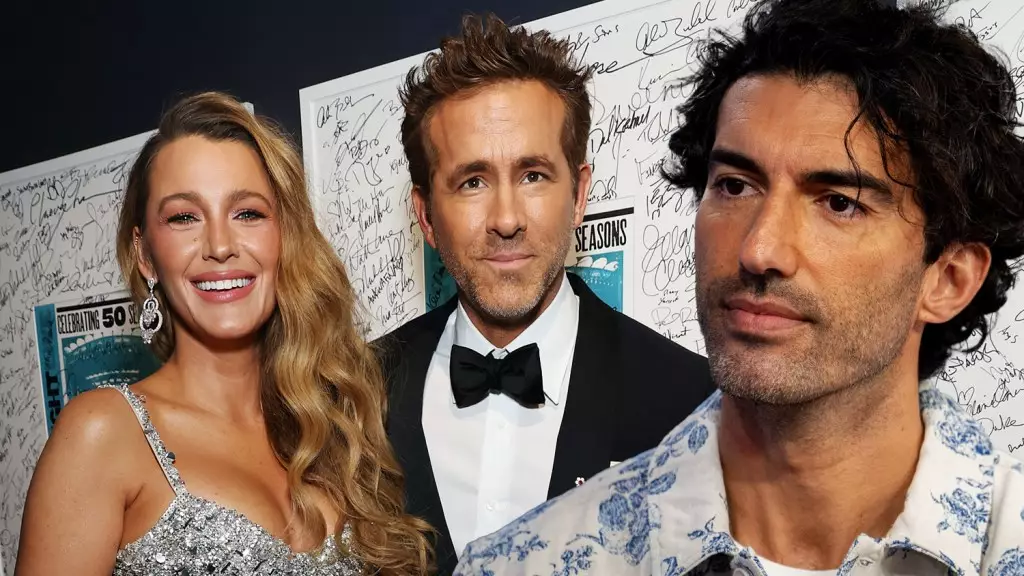The ongoing legal conflict among prominent Hollywood figures Blake Lively, Ryan Reynolds, Justin Baldoni, and their respective public relations firms has descended into a complicated web of allegations and counterclaims. At the heart of this dispute is Leslie Sloane, a publicist representing Lively and Reynolds, who is vehemently defending her clients against accusations linked to Baldoni’s alleged misconduct. The case underscores a broader examination of the chaotic interface between celebrity culture, public relations, and the legal system.
The essence of the legal squabble revolves around Baldoni’s substantial $400 million defamation and extortion lawsuit. The allegations include claims of “bizarre and abusive practices” purportedly employed by Baldoni, which Sloane and her company, Vision PR, seek to dissociate themselves from. In legal documents, Sloane’s team asserts that the accusations against them serve as a mere “smoke and mirrors exercise,” intended to divert attention from Baldoni’s own alleged misconduct. This highlights a crucial aspect of celebrity legal battles: the all-out war over public perception.
Allegations extended in the litigation reveal a chaotic backdrop of mutual recrimination, where accusations of sexual harassment and retaliation have surfaced. Both parties have dismissed suggestions for mediation, indicating an unwillingness to resolve the matter outside of a courtroom setting. This raises pressing questions about the motivations behind these legal maneuvers, most prominently whether individuals are leveraging legal channels as a method of publicity rather than genuine quest for justice.
Sloane’s request for dismissal from this legal fray pulls back the curtain on the intersection of public relations and law, emphasizing how PR firms can become embroiled in the conflicts of their clients. In a Hollywood landscape where image management is paramount, Sloane’s defense underscores both the importance and vulnerability of PR firms who are navigating the treacherous waters of their clients’ controversies.
Document filings state that Baldoni’s team does not adequately support their claims of defamation or extortion. Sloane’s attorneys argue that the accusations lack specificity and fail to adhere to fundamental legal standards. This criticism not only targets the claims themselves but reflects a larger pattern within celebrity disputes where the lines of accountability can become obscured. Is it the publicist’s role to mitigate damage, or should they also be subject to scrutiny as they maneuver through the turbulent waters of public scandals?
Another lens through which to analyze this conflict is the role of media coverage. The ongoing feud has blossomed into a media spectacle, with different factions vying for sympathy and support. Social media platforms and news outlets amplify narratives, constructing a public dialogue that shapes perceptions about the involved parties. As the case gains traction, there is an inherent risk that the discourse strays from substantive legal principles into sensationalism.
The stakes are high, given that the trial is scheduled for March 29, 2026, in New York City. Each iteration of court filings deepens public interest and scrutiny, forcing the involved parties into a limelight that few can withstand. Within this vortex, the personal narratives of Lively, Reynolds, and Baldoni become commodified, illustrating how the detailed ins and outs of their lives can quickly become fodder for public consumption rather than a private matter of rectifying alleged wrongdoings.
The ongoing case serves as a case study in the ramifications of public scrutiny. The “Dark Arts” of public relations are under examination, revealing how tactics previously employed to safeguard reputations can be utilized to undermine adversaries. The allegations that messages were sent to discredit Lively epitomize the lengths to which some might go in the battle for public favor.
As the legal proceedings progress, the conflicting narratives highlight the crossover between reputational management and ethical obligations. Ultimately, the chilling effects of this extensive public and legal scrutiny may dampen the willingness of individuals within the industry to seek redress through legal channels, knowing that the fallout may extend beyond the courtroom and into the court of public opinion.
As this intricate legal battle unfolds, it serves as a mirror reflecting the complexities of the entertainment ecosystem, where celebrity status, public relations, and the law intersect. Consequently, the case will be pivotal in determining how accountability is enforced for both actions and public narratives in the industry. The outcome may not only affect the parties involved but could also redefine expectations around transparency and ethics in the world of stardom and its myriad representations in the public sphere.
